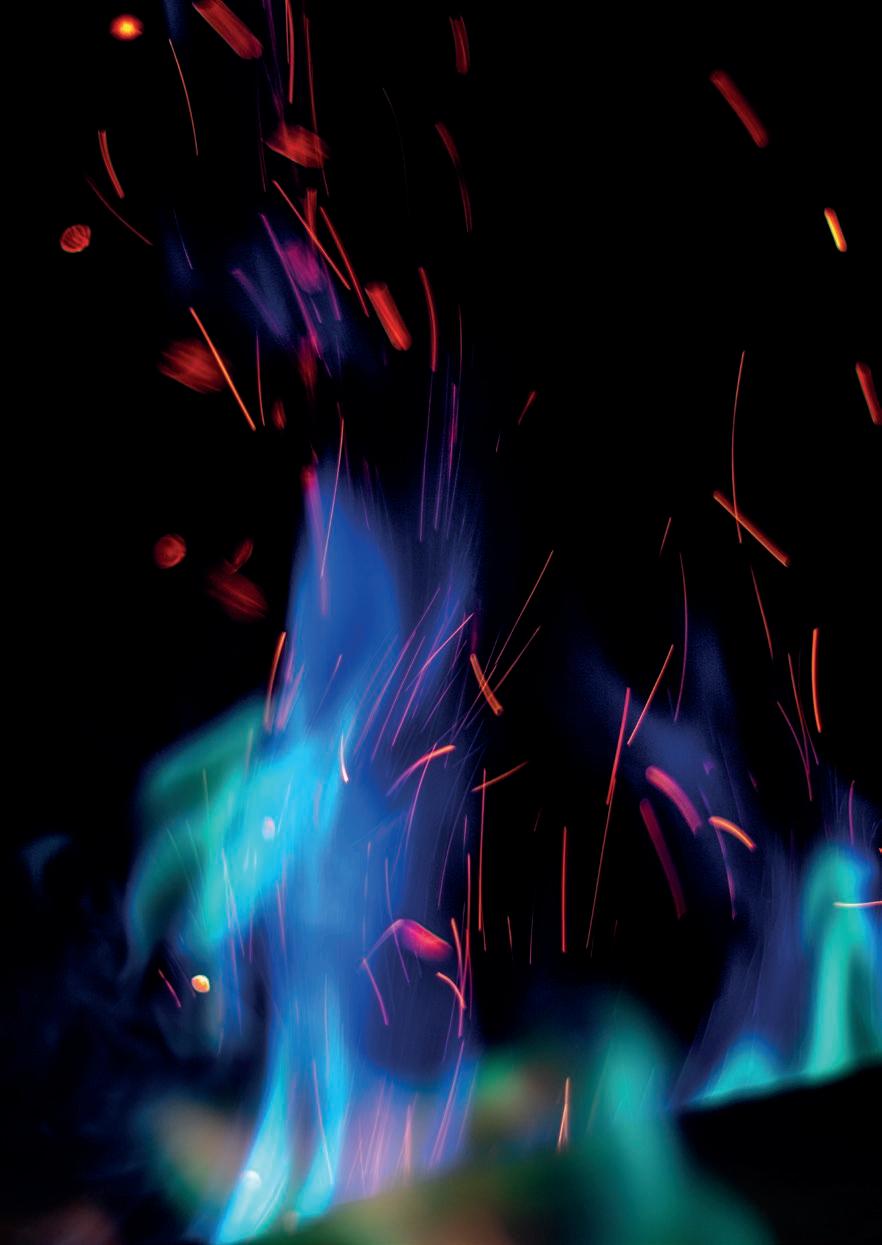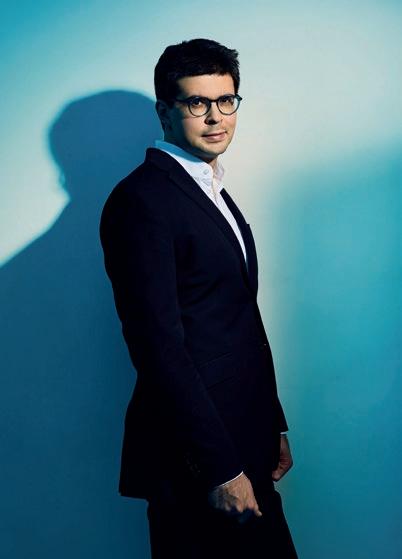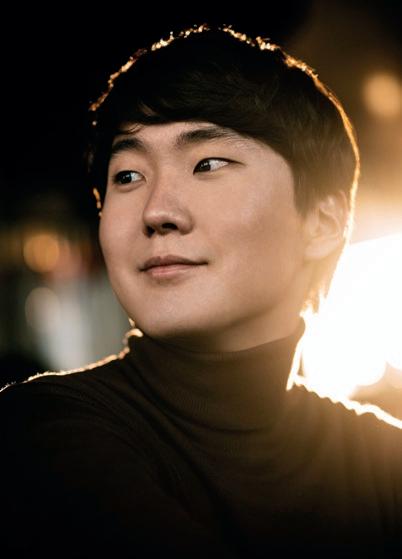

PROGRAMME
conductor Valentin Uryupin piano Seong-Jin Cho
Wolfgang Amadeus Mozart (1756–1791)
Piano Concerto No. 9 in E flat major, K. 217 ‘Jeunehomme’ (1777)
• Allegro
• Andantino
• Rondo: presto
intermission
Sergei Prokofiev (1891-1953)
Suite from Romeo and Juliet (1935/1940):
• Montagues and Capulets (The Prince Gives His Order – Dance of the Knights)
• Scene (The Street Awakens)
• Juliet as a Young Girl
• Minuet (The Arrival of the Guests)
• Masks
• Romeo and Juliet (Balcony Scene – Love Dance)
• Death of Tybalt
• Romeo and Juliet Before Parting
• The Nurse
• Friar Laurence
• Romeo at Juliet’s Tomb
• The Death of Juliet
Concert ends at around 22.15
Most recent performances by our orchestra:
Mozart Piano Concerto No. 9: Mar 2024, piano
Daniil Trifonov, conductor Lahav Shani (on tour)
Prokofiev Romeo and Julia (suite): Sep 2023, conductor Lahav Shani
One hour before the start of the concert, Emanuel Overbeeke will give an introduction (in Dutch) to the programme, admission €5. Tickets are available at the hall, payment by debit card. The introduction is free for Vrienden.
Cover: Photo Patrick Hendry (Unsplashed).
Illustration: omeo and Juliet: balcony scene. Engraving by Richard Rhodes (1815) after an illustration by John Thurston. Coll. The British MuseumBritish Museum


 Wolfgang Amadeus Mozart as Knight of the Golden Spur. Anonymous copy (1777) of a portrait by Padre Martini. Coll. Music Museum Bologna
Wolfgang Amadeus Mozart as Knight of the Golden Spur. Anonymous copy (1777) of a portrait by Padre Martini. Coll. Music Museum Bologna
Drama for the concert hall
A seemingly innocuous piano concerto by Mozart as a prelude to Prokofiev’s forbidding yet uplifting ballet music based on the tragic story of Romeo and Juliet: that is not as strange as it might seem.
Along with Joseph Haydn, Wolfgang Amadeus Mozart was a great example for Sergei Prokofiev, who showed in his First Symphony that he had a good command of their classical style. And like Prokofiev, Mozart enjoyed adding drama to his music, as is the case with his Piano Concerto in E flat major K. 271. You can interpret the dialogue between piano and orchestra in that concerto as a friendly mirror image of ‘Montagues and Capulets’ from Prokofiev’s ballet music to Romeo and Juliet, in which we hear the fateful rivalry between two noble families.
Wolfgang and Victoire
Although, when compared with Prokofiev’s brutal sounds, Mozart’s refined music seems to emanate from another universe, the young composer was definitely ahead of his time in the way in which he juxtaposed the piano and the orchestra. Mozart’s Piano Concerto No. 9 in E flat major K. 271, written in 1777, can be
seen as the transition from his early works to full maturity. It was believed for many years that Mozart had dedicated the concerto to a French pianist, about whom nothing was known other than that her name was Jeunehomme – so that is the name by which this concerto became known. In 2004 the Viennese musicologist Michael Lorenz found out the real story. Mozart did not write his concerto for someone called Jeunehomme, but for Victoire Jenamy, daughter of the dancer and choreographer Jean Georges Noverre, who was a good friend of the Mozart family. In a letter to his father dating from September 1778 Mozart refers to the work as the ‘concerto for Jenomy’. Although Victoire Jenamy was not a professional pianist, Mozart admired her playing enormously and gave her the longest, best and most adventurous piano concerto he had so far composed. Without waiting for the customary orchestral introduction, the soloist begins a sparkling dialogue with the orchestra after only a few notes. This pattern is repeated throughout the first movement: the orchestra starts and the piano responds. Only once, shortly before the reprise, does Mozart reverse the order. In the introspective second movement Mozart introduces the instrumental recitative. In their comprehensive biography from the 1920s
Teodor Wyzewa and Georges de Saint-Foix aptly compared this movement to a ‘tragic recitative from an opera by Gluck’. The final movement is a brilliant rondo that is full of novelty. Although the layout appears simplea theme, introduced by the soloist, that recurs regularly and is interspersed with episodes made up of other material - Mozart included a number of surprises. The biggest is probably the third episode, in which a genuine minuet pops up, as if Mozart wanted to slot in a complete extra movement with a contrasting mood and tempo. Youthful swagger or a sign of maturity? In any event, this is the first of Mozart’s major piano concertos.
Youthful swagger or a sign of maturity? In any event, this is the first of Mozart’s major piano concertos.
Romeo and Juliet
Having fled his fatherland during the Russian Revolution, Sergei Prokofiev turned into a real cosmopolitan with a style of his own that was worlds away from that of 19th-century Russian music. He lived and worked for a while in the USA, then spent some time in Paris and in various other places in Europe, but in 1936 – to the amazement of many – he returned to Russia. In hindsight, you could say that he had already announced his return in his music – for instance in Romeo and Juliet (1935), a ballet based on Shakespeare’s wellknown eponymous play: as well as a classical, Mozartian grasp of form and a French-style treatment of the orchestra, the Russian
soul is never very far away in this score. The simplicity of the melodies, the upbeat rhythms, the harmonies that emerge from the orchestra like whipcracks – these are all elements prevalent in Russian folk music. In addition, in Romeo and Juliet Prokofiev aligns with the strong Russian ballet tradition. But even though nowadays it is far and away the most popular 20th-century ballet music, Prokofiev had to fight to get his score accepted in the Russia of the 1930s. The Kirov Ballet, which had commissioned him to write a full-length ballet of his choice, rejected Prokofiev’s proposal of a work based on Romeo and Juliet. The composer then offered his ballet to the Bolshoi Theatre, initially with success, but on further reflection the score was declared ‘undanceable’. So that the music could at least be played in the concert hall, in 1936 Prokofiev condensed fragments from the score into two symphonic suites, adding a third ten years later.
In the end, the complete ballet was premiered in 1938 in Brno, Czechoslovakia. It was such a success that the Kirov Ballet soon added the work to its repertoire and gave its Russian premiere in 1940. As well as the ballet itself, the orchestral suites became popular too. Over the years, many orchestras have made their own compilations based on the three suites. And that is the case today. The ballet, which lasts two and a half hours and has four acts and nine scenes, can be heard in a version that encapsulates the story of the ill-fated love of Romeo and Juliet by combining parts of the suites chronologically. Thanks to the visual power of Prokofiev’s music the story can therefore be followed easily, even by those who are not familiar with its dramatic content.
Paul Janssen
Seong-Jin Cho • piano
Born: Seoul, South Korea
Education: first piano lessons at age six, study with Michel Béroff at the Conservatoire National Supérieur, Paris, and under the mentorship of Alfred Brendel
Awards: Hamamatsu International Piano Competition 2009 (as youngest winner ever), International Tchaikovsky Competition, 2011
Breakthrough: 2015: First Prize in the International Chopin Competition, Warsaw
Solo appearances: Berlin Philharmonic, London Symphony Orchestra, Munich Philharmonic, Deutsches SymphonieOrchester Berlin, Orchestre de Paris, Philadelphia Orchestra, Los Angeles Philharmonic, Mariinsky Orchestra
Solo recitals: Carnegie Hall New York, Philharmonie Berlin, Concertgebouw Amsterdam, Suntory Hall Tokyo, festivals of La Roque d’Anthéron, Verbier, Gstaad Debut Rotterdam Philharmonic: 2021
Valentin Uryupin • conductor
Born: Lozova, Ukraine
Education: clarinet and conducting at the Moscow State Conservatory with Evgeny Petrov and Gennadi Rozhdestvensky, masterclass with Kurt Masur, assistantships with Vladimir Jurowski, Valery Gergiev, Teodor Currentzis
Awards: Gustav Mahler Conducting Competition 2016 (Third Prize)
Breakthrough: 2017, winner Sir Georg Solti Conducting Competition, Frankfurt
Subsequently: guest appearances with Vienna Symphony Orchestra, Deutsches Symphonie-Orchester Berlin, SWR Symphonieorchester, Netherlands
Philharmonic Orchestra, New Japan
Philharmonic, Mariinsky Orchestra; Chief Conductor Rostov Symphony Orchestra (2015–2021) and Novaya Opera Moscow (2021–2022); opera with the State Operas of Berlin, Hanover, Stuttgart, Teatro Real Madrid, Athens Opera, Bregenz Festival
Debut Rotterdam Philharmonic: 2024
 Photo: Daniil Rabovsky
Photo: Christoph Köstlin
Photo: Daniil Rabovsky
Photo: Christoph Köstlin
Agenda
Fri 5 April 2024 • 20.15
Sun 7 April 2024 • 14.15
conductor Jukka-Pekka Saraste violin Johan Dalene
Mendelssohn Violin Concerto
Bruckner Symphony No. 7
Proms: Spring Is In The Air
Fri 19 April 2024 • 20.30
leader Marieke Blankestijn violin Kira van der Woerd
Vivaldi The Four Seasons: Spring
Pachelbel Canon and Gigue
Handel Concerto Grosso Op.6
No.4
Bach Air from Suite No. 3
Vivaldi The Four Seasons: Summer
Fri 26 April 2024 • 18.00
conductor Yannick Nézet-Séguin
Siegmund Stanislas de Barbeyrac
Sieglinde
Elza van den Heever
Hunding Soloman Howard
Wotan Brian Mulligan
Brünnhilde Tamara Wilson
Fricka Karen Cargill
Wagner Die Walküre
Thu 2 May 2024 • 20.15
conductor Yannick Nézet-Séguin violin Randall Goosby
Dvořák Overture Carnival
Price Violin Concerto No. 2
Price Adoration
Brahms Symphony No. 4
Musicians
Chief Conductor
Lahav Shani
Honorary Conductor
Yannick Nézet-Séguin
Principal Guest Conductor
Tarmo Peltokoski
First Violin
Marieke Blankestijn, concertmeester
Quirine Scheffers
Hed Yaron Meyerson
Saskia Otto
Arno Bons
Mireille van der Wart
Rachel Browne
Maria Dingjan
Marie-José Schrijner
Noëmi Bodden
Petra Visser
Sophia Torrenga
Hadewijch Hofland
Annerien Stuker
Alexandra van
Beveren
Second Violin
Charlotte Potgieter
Cecilia Ziano
Frank de Groot
Laurens van Vliet
Tomoko Hara
Elina Staphorsius
Jun Yi Dou
Bob Bruyn
Eefje Habraken
Maija Reinikainen
Wim Ruitenbeek
Babette van den Berg
Melanie Broers
Lana Trimmer
Viola
Anne Huser
Roman Spitzer
Galahad Samson
José Moura Nunes
Kerstin Bonk
Lex Prummel
Janine Baller
Francis Saunders
Veronika Lénártová
Rosalinde Kluck
León van den Berg
Olfje van der Klein
Cello
Emanuele Silvestri
Eugene Lifschitz
Joanna Pachucka
Daniel Petrovitsch
Mario Rio
Gé van Leeuwen
Eelco Beinema
Carla Schrijner
Pepijn Meeuws
Yi-Ting Fang
Double Bass
Matthew Midgley
Ying Lai Green
Jonathan Focquaert
Robert Franenberg
Harke Wiersma
Arjen Leendertz
Ricardo Neto
Flute
Juliette Hurel
Joséphine Olech
Flute/piccolo
Beatriz Da Baião
Oboe
Remco de Vries
Karel Schoofs
Anja van der Maten
Oboe/Cor Anglais
Ron Tijhuis
Clarinet
Julien Hervé
Bruno Bonansea
Clarinet/ Bass Clarinet
Romke-Jan Wijmenga
Bassoon
Pieter Nuytten
Lola Descours
Marianne Prommel
Bassoon/ Contrabassoon
Hans Wisse
Horn
David Fernández Alonso
Felipe Santos Freitas Silva
Wendy Leliveld
Richard Speetjens
Laurens Otto
Pierre Buizer
Trumpet
Alex Elia
Simon Wierenga
Jos Verspagen
Trombone
Pierre Volders
Alexander Verbeek
Remko de Jager
Bass trombone
Rommert Groenhof
Tuba
Hendrik-Jan Renes
Percussion
Danny van de Wal
Ronald Ent
Martijn Boom
Adriaan Feyaerts
Harp
Charlotte Sprenkels
